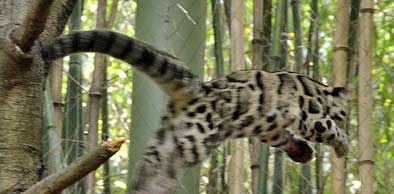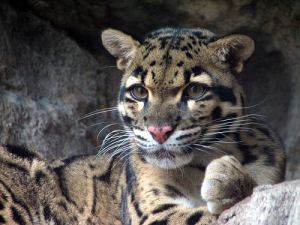A rare clouded leopard was trapped by a Cornish farmer, after wandering around the countryside allegedly feeding on sheep. The evidence points to the escape of this cat from an enclosure owned by a man, Todd Dalton, who had relocated from London where he had kept two clouded leopards, an ocelot and a margay in an enclosure in his back yard.

Dalton wants to breed these cats as they are endangered (classified as ‘Vulnerable’ by IUCN Red List). He is an amateur who somehow obtained a dangerous wild animal license from DEFRA to keep them.
It appears that his enclosure was insecure and the clouded leopard escaped. He allegedly did not tell anyone. This endangered the leopard and the local residents. Although the clouded leopard is a medium sized cat and no where near as large or as dangerous as the common leopard.

Dalton has refused to comment to the Times newspaper, the source of the story but the police reported a leopard escape from a private property around Great Treverran on Boxing Day. The cat was recaptured on New Years Eve.
A neighbour, Peter Howard, said that the terms of Dalton’s license had been breached and it should be revoked as the enclosure was unsafe.

Comment: It is not good enough for a British amateur to be involved in this sort of private wild cat zoo enterprise with aspirations to breed them. It is very hard to breed captive wild cats and they should be left in the wild to breed naturally. Where did he get them from? The authorities should be asking questions and then revoke his license.
The clouded leopard’s habitat in the Far East is being destroyed by loggers and the cat killed by poachers. The cat is arboreal (a tree dweller) and has a long and thick tail as evidence because a cat’s tail is used for balance.


Trying to breed in captivity to increase the population of a big cat requires an extensive gene pool.
The demented folk who keep tigers as pets will try and tell you they are saving the species when educated animal specialists will tell you the tigers they breed have too many genetic defects from inbreeding to ever be used as breeding animals.
While this particular cat might not pose a serious threat to adults children would be easy prey.
Yes, I completely agree with you as usual. To me it is shocking that an individual like this can play around with the idea of breeding precious wild cat species in England on an amateur basis because some idiot in a government department allowed him to have a licence. It points as much to the inefficiency and slackness of government as it does to the misguided desires of an individual.